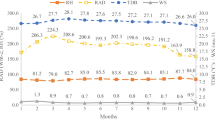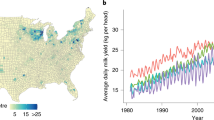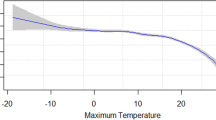Abstract
There are clear signs that milk production growth is leveling off, and recently even declining, in China. Heat stress is one of the main reasons for the recent reduction in milk production. In this study, we computed the change in milk production as a result of heat stress in major milk production areas in China. We constructed a temperature–humidity index (THI) spatial layer to understand the monthly distribution of heat and moisture. We documented specific areas in northern China where cattle were at high risk to heat stress in specific months. THI values exceeded the threshold above which milk production declines during months of June, July, and August. Especially during July, the THI value was higher than the production threshold in recent years (2008 to 2016) and in projected future scenarios (2050 and 2070). THI-based milk yield losses were up from 0.7 to about 4 kg per cow per day in July 2016. These losses are projected to increase from 1.5 to 6.5 kg in 2050 and 2 to 7.2 kg in 2070 (representing production losses between 15 and 50%). These results suggest that climate change will have significant consequences for the dairy sector in major milk-producing areas in China. Our results are useful in identifying areas susceptible to heat stress where adaptive livestock management practices are needed to prevent significant production decreases.







Similar content being viewed by others
References
Abdela N (2016) Sub-acute ruminal acidosis (SARA) and its consequence in dairy cattle: a review of past and recent research at global prospective. Achiev Life Sci 10(2):87–196. https://doi.org/10.1016/j.als.2016.11.006
Aggarwal A, Upadhyay R (2013) Heat stress and milk production. In: Aggarwal A, Upadhyay R (eds) Heat stress and animal productivity. Springer, India, pp 53–77
Alexandratos N, Bruinsma J (2012) World agriculture towards 2030/2050: the 2012 revision
Allore HG, Oltenacu PA, Erb HN (1997) Effects of season, herd size , and geographic region on the composition and quality of milk in the northeast 1. J Dairy Sci 80:3040–3049. https://doi.org/10.3168/jds.S0022-0302(97)76271-4
Bai Z, Lee MR, Ma L et al (2018a) Global environmental costs of China’s thirst for milk. Clobal Chang Biol 24:2198–2211. https://doi.org/10.1111/gcb.14047
Bai Z, Ma W, Ma L et al (2018b) China’s livestock transition: driving forces, impacts, and consequences. Sci Adv 4:eaar8534. https://doi.org/10.1126/sciadv.aar8534
Barbosa AM, Real R (2012) Applying fuzzy logic to comparative distribution modelling: a case study with two sympatric amphibians. Sci World J 2012:ID 428206. doi: https://doi.org/10.1100/2012/428206
Baumgard L, Rhoads R (2012) Effects of heat stress on postabsorptive metabolism and energetics. Annu Rev Anim Biosci 1:311–337
Berhanu B, Seleshi Y, Demisse S, Melesse A (2016) Bias correction and characterization of climate forecast system re-analysis daily precipitation in Ethiopia using fuzzy overlay. Meteorol Appl 23:230–243
Bernabucci U, Biffani S, Buggiotti L et al (2014) The effects of heat stress in Italian Holstein dairy cattle. J Dairy Sci 97:471–486
Bertocchi L, Vitali A, Lacetera N et al (2014) Seasonal variations in the composition of Holstein cow’s milk and temperature-humidity index relationship. Animal 8:667–674. https://doi.org/10.1017/S1751731114000032
Bohmanova J, Misztal I, Cole J (2007) Temperature-humidity indices as indicators of milk production losses due to heat stress. J Dairy Sci 90:1947–1956
Bouraoui R, Lahmar M, Majdoub A et al (2002) The relationship of temperature-humidity index with milk production of dairy cows in a Mediterranean climate. Anim Res 51:479–491
Broxton PD, Zeng X, Sulla-Menashe D, Troch PA (2014) A global land cover climatology using MODIS data. J Appl Meteorol Climatol 53:1593–1605. https://doi.org/10.1175/JAMC-D-13-0270.1
Bruegemann K, Gernand E, von Borstel U, Koenig S (2012) Defining and evaluating heat stress thresholds in different dairy cow production systems. Arch fur Tierzucht 55:13–24
Bryant JR, López-Villalobos N, Pryce JE et al (2007) Quantifying the effect of thermal environment on production traits in three breeds of dairy cattle in New Zealand. New Zeal J Agric Res 50:327–338. https://doi.org/10.1080/00288230709510301
DAH and NAHS (2018) Development situation of animal husbandry in 2017 and prospect report in 2018 (in Chinese). Department of Animal Husbandry and National Livestock Station. China Agricultural Science and Technology Press, Beijing
Dash S, Chakravarty AK, Singh A et al (2016) Effect of heat stress on reproductive performances of dairy cattle and buffaloes: a review. Vet World 9:235–244. https://doi.org/10.14202/vetworld.2016.235-244
De Rensis F, Garcia-ispierto I, López-gatius F (2015) Theriogenology seasonal heat stress: clinical implications and hormone treatments for the fertility of dairy cows. Theriogenology 84:659–666. https://doi.org/10.1016/j.theriogenology.2015.04.021
Dikmen S, Hansen P (2009) Is the temperature-humidity index the best indicator of heat stress in lactating dairy cows in a subtropical environment? J Dairy Sci 92:109–116. https://doi.org/10.3168/jds.2008-1370
Dunn RJH, Mead NE, Willett KM, Parker DE (2014) Analysis of heat stress in UK dairy cattle and impact on milk yields. Environ Res Lett 9. https://doi.org/10.1088/1748-9326/9/6/064006
FAO (2018) Livestock primary. FAOSTAT Stat. Database. URL http://www.fao.org/faostat/en/#data/QL. Accessed 27 Jul 2019
Fick SE, Hijmans RJ (2017) Worldclim 2: new 1-km spatial resolution climate surfaces for global land areas. Int J Climatol 37:4302–4315
Gao S, Guo J, Quan S et al (2017) The effects of heat stress on protein metabolism in lactating Holstein cows. J Dairy Sci 100:5040–5049
Gao S, Ma L, Zhou Z et al (2019) Heat stress negatively affects the transcriptome related to overall metabolism and milk protein synthesis in mammary tissue of midlactating dairy cows. Physiol Genomics 51:400–409
Hall G, Wang F, Subaryono J (1992) Comparison of Boolean and fuzzy classification methods in land suitability analysis by using geographical information systems. Environ Plan A 24:497–516
Hansen P (2007) Exploitation of genetic and physiological determinants of embryonic resistance to elevated temperature to improve embryonic survival in dairy cattle during heat stress. Theriogenology 68:242–249
Hattab T, Ben R, Albouy C et al (2013) The use of a predictive habitat model and a fuzzy logic approach for marine management and planning. PLoS One 8:e76430
Herrero M, Thornton PK, Sones K et al (2013) Livestock and global change: emerging issues for sustainable food systems. Proc Natl Acad Sci 110:20878–20881. https://doi.org/10.1073/PNAS.1321844111
Kadzere CT, Murphy MR, Silanikove N, Maltz E (2002) Heat stress in lactating dairy cows: a review. Livest Prod Sci 77:59–91. https://doi.org/10.1016/S0301-6226(01)00330-X
Kearney J (2010) Food consumption trends and drivers. Philos Trans R Soc B Biol Sci 365:2793–2807. https://doi.org/10.1098/rstb.2010.0149
Li Q, Yang S, Xu W et al (2015) China experiencing the recent warming hiatus. Geophys Res Lett 42:889–898. https://doi.org/10.1002/2014gl062773
Mader T, Davis M, Brown-Brandl T (2006) Environmental factors influencing heat-stress in feedlot cattle. J Anim Sci 84:712–719
Mauger G, Bauman Y, Nennich T, Salathé E (2015) Impacts of climate change on milk production in the United States. Prof Geogr 67:121–131. https://doi.org/10.1080/00330124.2014.921017
Mesgari M, Pirmoradi A, Fallahi G (2008) Implementation of overlay function based on fuzzy logic in spatial decision support system. World Appl Sci J 3:60–65
NARCC (2011) Second National Assessment Report on Climate Change (In Chinese). National Assessment Report on Climate Change. Sciences Press, Beijing
Nardone A, Ronchi B, Lacetera N et al (2010) Effects of climate changes on animal production and sustainability of livestock systems. Livest Sci 130:57–69. https://doi.org/10.1016/j.livsci.2010.02.011
Nokels L, Fahmy T, Crochemore S (2010) Interpretation of the preferences of automotive customers applied to air conditioning supports by combining GPA and PLS regression. In: Esposito Vinzi V, Chin W, Henseler J, Wang H (eds) Handbook of partial least squares: concepts, methods and application. pp 775–789
NRC (1981) A guide to environmental research on animals. National Research Council, National Academy of Sciences, Washington DC
Polsky L, von Keyserlingk MAG (2017) Effects of heat stress on dairy cattle welfare. J Dairy Sci 100:8645–8657. https://doi.org/10.3168/jds.2017-12651
Pragna P, Archana P, Aleena J et al (2016) Heat stress and dairy cow: impact on both milk yield and composition. Int J Dairy Sci 12:1–11
Qiu F, Chastain B, Zhou Y et al (2014) Modeling land suitability/capability using fuzzy evaluation. GeoJournal 79:167–182
Ranjitkar S, Sujakhu NM, Lu Y et al (2016) Climate modelling for agroforestry species selection in Yunnan Province. China Environ Model Softw 75. https://doi.org/10.1016/j.envsoft.2015.10.027
Ravagnolo O, Misztal I, Hoogenboom G (2000) Genetic component of heat stress in cattle, development of heat index function. J Dairy Sci 83:2120–2125
Rhoads M, Rhoads R, VanBaale M et al (2009) Effects of heat stress and plane of nutrition on lactating Holstein cows: I. Production, metabolism, and aspects of circulating somatotropin. J Dairy Sci 92:1986–1997
Robertson M, Villet M, Palmer A (2004) A fuzzy classification technique for predicting species’ distributions: applications using invasive alien plants and indigenous insects. Divers Distrib 10:461–474
Silanikove N, Koluman N (2015) Impact of climate change on the dairy industry in temperate zones: predications on the overall negative impact and on the positive role of dairy goats in adaptation to earth warming. Small Rumin Res 123:27–34. https://doi.org/10.1016/j.smallrumres.2014.11.005
St-Pierre N, Cobanov B, Schnitkey G (2003) Economic losses from heat stress by US livestock industries. J Dairy Sci 86:E52–E77. https://doi.org/10.3168/jds.S0022-0302(03)74040-5
Tenenhaus M, Pages J, Ambroisine L, Guinot C (2005) PLS methodology to study relationships between hedonic judgments and product characteristics. Food Qual Prefer 16:315–325. https://doi.org/10.1016/j.foodqual.2004.05.013
Thornton PK (2010) Livestock production: recent trends, future prospects. Philos Trans R Soc B Biol Sci 365:2853–2867. https://doi.org/10.1098/rstb.2010.0134
Tilman D, Clark M (2014) Global diets link environmental sustainability and human health. Nature 515:518
Upadhyay R, Singh S, Kumar A et al (2007) Impact of climate change on milk production of Murrah buffaloes. Ital J Anim Sci 6:1329–1332. https://doi.org/10.4081/ijas.2007.s2.1329
Upadhyay R, Kumar A, Gupta S et al (2009) Inventory of methane emission from livestock in India. In: Aggarwal P (ed) Global climate change and Indian agriculture. Case studies from the ICAR Network project. The Indian Council of Agricultural Research (ICAR), New Delhi, pp 117–122
Wang Y, Ren F, Zhang X (2014) Spatial and temporal variations of regional high temperature events in China. Int J Climatol 34:3054–3065. https://doi.org/10.1002/joc.3893
West J (2003) Effects of heat-stress on production in dairy cattle. J Dairy Sci 86:2131–2144
West J, Mullinix B, Bernard J (2003) Effects of hot, humid weather on milk temperature, dry matter intake, and milk yield of lactating dairy cows. J Dairy Sci 86:232–242
Wheelock J, Rhoads R, VanBaale M et al (2010) Effects of heat stress on energetic metabolism in lactating Holstein cows. J Dairy Sci 93:644–655
Wildridge AM, Thomson PC, Garcia SC et al (2018) Short communication: the effect of temperature-humidity index on milk yield and milking frequency of dairy cows in pasture-based automatic milking systems. J Dairy Sci 101:4479–4482. https://doi.org/10.3168/jds.2017-13867
Wiley AS (2007) The globalization of cow’s milk production and consumption: biocultural perspective. Ecol Food Nutr 48:281–312. https://doi.org/10.1080/03670240701407657
Xiao-ge X, Tong-wen W, Jiang-long L et al (2013) How well does BCC _ CSM1 .1 reproduce the 20th century climate change over China? Atmos Ocean Sci Lett 6:21–26. https://doi.org/10.1080/16742834.2013.11447053
Xiao-Juan W, Zhi-Qiang G, Fu-Min R, Guo-Lin F (2013) Spatial-temporal characteristics of regional extreme low temperature events in China during 1960–2009. Adv Clim Chang Res 3:186–194. https://doi.org/10.3724/sp.j.1248.2012.00186
Xin X, Zhang L, Zhang J et al (2013) Climate change projections over East Asia with BCC _ CSM1 . 1 climate model under RCP scenarios. J Meteorol Soc Japan 91:413–429. https://doi.org/10.2151/jmsj.2013-401
Yano M, Shimadzu H, Endo T (2014) Modelling temperature effects on milk production: a study on Holstein cows at a Japanese farm. Springerplus 3:129
Zhou Y, Ren G (2010) Variation of extreme temperature events on Mainland China, 1956–2008. Clim Environ Res 15:405–417
Zimbelman RB, Rhoads RP, Rhoads ML et al (2009) A re-evaluation of the impact of temperature humidity index (THI) and black globe humidity index (BGHI) on milk production in high producing dairy cows. Proc Southwest Nutr Conf:158–169
Acknowledgments
The research was financially supported by Dairy census program by the Ministry of Agricultural and Rural Affairs, National Natural Science Foundation of China (31872383), National Key Research and Development Program of China (2018YFD0501600), and Agricultural Science and Technology Innovation Program (ASTIP-IAS07; CAAS-XTCX2016011-01), Beijing Dairy Industry Innovation Team (BAIC06-2020). We would like to acknowledge Dr. Eike Luedeling for providing comments on the early draft of the manuscript that help us to revise the analysis and sincere thanks to Austin G Smith for English editing.
Author information
Authors and Affiliations
Corresponding author
Additional information
Publisher’s note
Springer Nature remains neutral with regard to jurisdictional claims in published maps and institutional affiliations.
Electronic supplementary material
ESM 1
(DOC 2395 kb)
Rights and permissions
About this article
Cite this article
Ranjitkar, S., Bu, D., Van Wijk, M. et al. Will heat stress take its toll on milk production in China?. Climatic Change 161, 637–652 (2020). https://doi.org/10.1007/s10584-020-02688-4
Received:
Accepted:
Published:
Issue Date:
DOI: https://doi.org/10.1007/s10584-020-02688-4




